The problem with categorizing species of boa snakes is that there is no solid ground rule on them. Most people read the words “forty species in the boa family” and assume that means there are 40 species of boa. The reality is, eight species fall under the boa umbrella, with another two that bounce back and forth.
This list consists of the classic boa constrictor, longicauda, occidentalis, ortonii, imperator, nebulosa, orophias, and amarali. There are many other species, though the research is lacking to the point where they are often thought of as subspecies and/or sometimes unrelated.
One thing is for sure, that narrows down the list quite a bit. What confuses most people is the inclusion of the number “40” and the word “species” in the same sentence. It’s easy to conclude that there are 40 species of boa. But we’ll stick with the primary boas on this one, and cover the other sub-species and associated species at the bottom.
1. Red-Tail Boa Constrictor (Boa constrictor constrictor)

Red-tail boas are native to Brazil.
©Leonardo Mercon/Shutterstock.com
This is the most common and recognized of the eight. While there were once ten or more (depending on who you talk to or where you’re standing), herpetologists no longer recognize those species. Most people who have boa constrictors at home, as pets, have red-tail boas, which is this, specific species.
The red-tail boa is native to South America and though the cultures of the North and South Americas differ wildly, they both share a propensity for keeping these red-tails as pets. However, South Americans also have a higher inclination towards killing and skinning red-tail boas, for either a private collection or to display publicly.
While they can reach up to 60 lbs, most average anywhere between 20 and 35 lbs, with the females often heavier than the males. Boa constrictor snakes typically feature color patterns related to their natural environment. Browns, creams, grays, tans, reds, and blacks are the various colors that usually apply to boas.
2. Long-Tail Boa Constrictor (Boa constrictor longicauda)
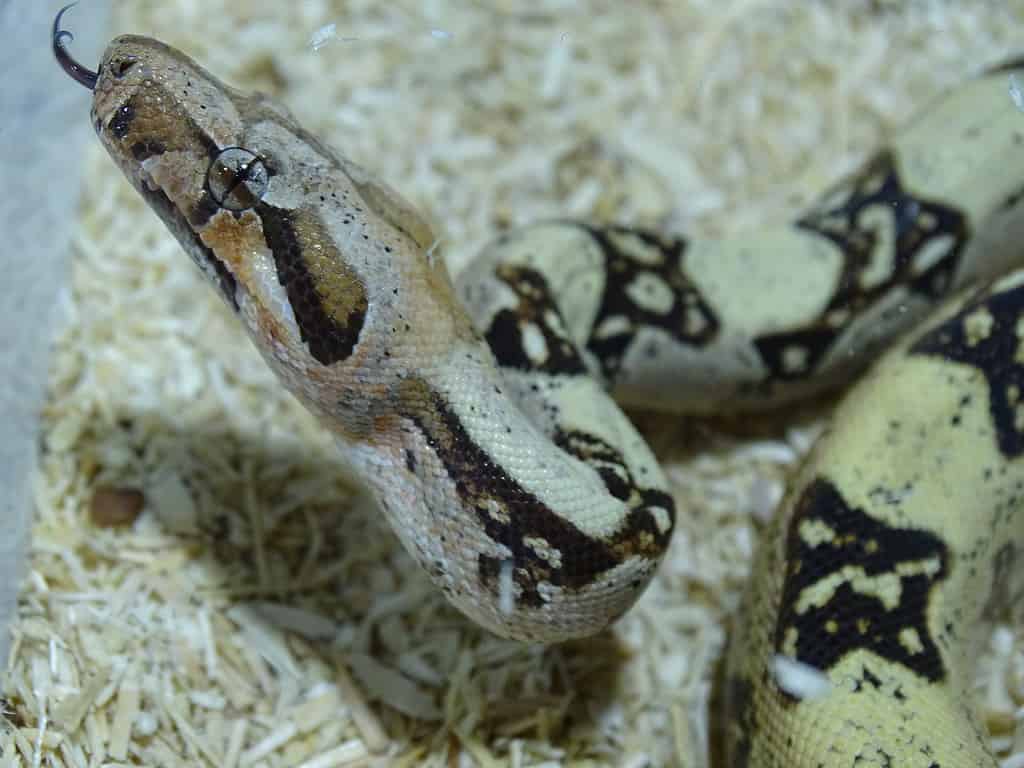
Long-tail boa looking up, expecting its next meal perhaps?
©Carlotta campus, CC BY 4.0, via Wikimedia Commons – License
Also known as Peruvian long-tail boas, these particular boa constrictor snakes grow to a length of 6′ to 7′. To the undiscerning eye, they look much like a classic boa constrictor, albeit a little leaner, with a more subtly streamlined profile.
This boa variation also tends to have darker, glossier hues than traditional boas. Strangely enough, their 6′ to 7′ length is not thought of as particularly lengthy, despite the heavy irony of their name. In terms of behavior and environment, they are very similar to classic boas in everything, including temperament, habitat, needs, and daily habits.
They’re surprisingly docile snakes and show very little aggression unless it’s feeding time. If you happen to be the happy owner of a long-tail boa, you’re not a rarity, though the standard boa is far more common as a household pet.
3. Argentine Boa Constrictor (Boa constrictor occidentalis)

Argentine boa lounging in the heat lamp.
©User:Bemoeial~commonswiki / CC BY-SA 3.0, from Wikimedia Commons, the free media repository – License
The Argentine boa constrictor snakes are much longer than their long-tail cousins, growing to lengths anywhere between 7′ and 10′. They also have a more unique color variation than either of the two boas above. An Argentine boa can be nearly black to very light creams and whites. Burnt orange is another common color variation frequently observed with Argentine boas.
As its name implies, these boas frequently range throughout Argentina, although they’re frequently seen farther south as well—in Cordoba and Mendoza. Females are capable of producing 40 baby boas at a time, though it’s usually more along the line of 20 to 30.
Though it’s rarer to see Argentine boas as pets, they aren’t any more difficult to care for than other boas. Since the rainforests throughout South America are frequently under threat, the continuing existence of Argentine boas intertwines with the survival of its most important habitat.
4. Orton’s Boa (Boa constrictor ortonii)
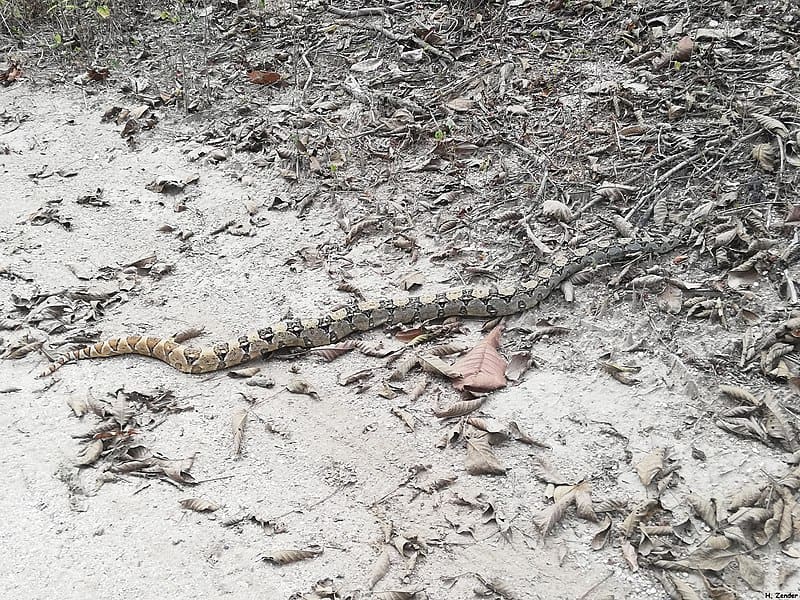
Why did the Orton’s boa cross the road?
©Harrison zender, CC BY-SA 4.0, via Wikimedia Commons – License
Sure, it has a funny name, but since Professor James Orton’s discovery of this particular boa (late 19th century), the name makes sense. Peruvian locals call it the macanche. Orton’s boa is unique from the other boas on this list because it prefers drier climates and stays well away from rainforest environments.
Orton’s boa constrictor snakes are light gray, tan, or traditional brown, with most of the recognizable patterns other boas display. A “drier” climate doesn’t infer desert, however, but more traditional forest areas and mountain environments are their preference.
Orton’s boas often engage in a ton of interbreeding with other boas, a natural result of sharing a habitat with other types of boas. This is probably why there is a deal of confusion surrounding the various boa species out there and how many of them there are.
5. Boa Imperator (Boa imperator)

IMG boa imperators are a color mutation that stands for “increased melanism gene.” It describes how their color changes as they age.
©reptiles4all/Shutterstock.com
Besides traditional boa constrictor snakes, boa imperators are probably the second-most common when it comes to pet ownership. Instead of South America, the boa constrictor imperator hails from Central America, and some scientists don’t think it’s a boa at all.
Despite that doubt, enough agree that it is to place it in the ‘full-species’ category. Unless you’re a herpetologist, you’ll find that it’s very difficult to tell an imperator apart from a standard constrictor. One of the biggest differences between the two is the behavior of captive imperators.
Wild-caught imperators that become pets in someone’s living room are far more likely to become defensive. Though a boa constrictor of any kind would have difficulty doing any lasting damage to a human, an imperator is still capable of biting with lightning speed.
6. Dominican Clouded Boa (Boa nebulosa)
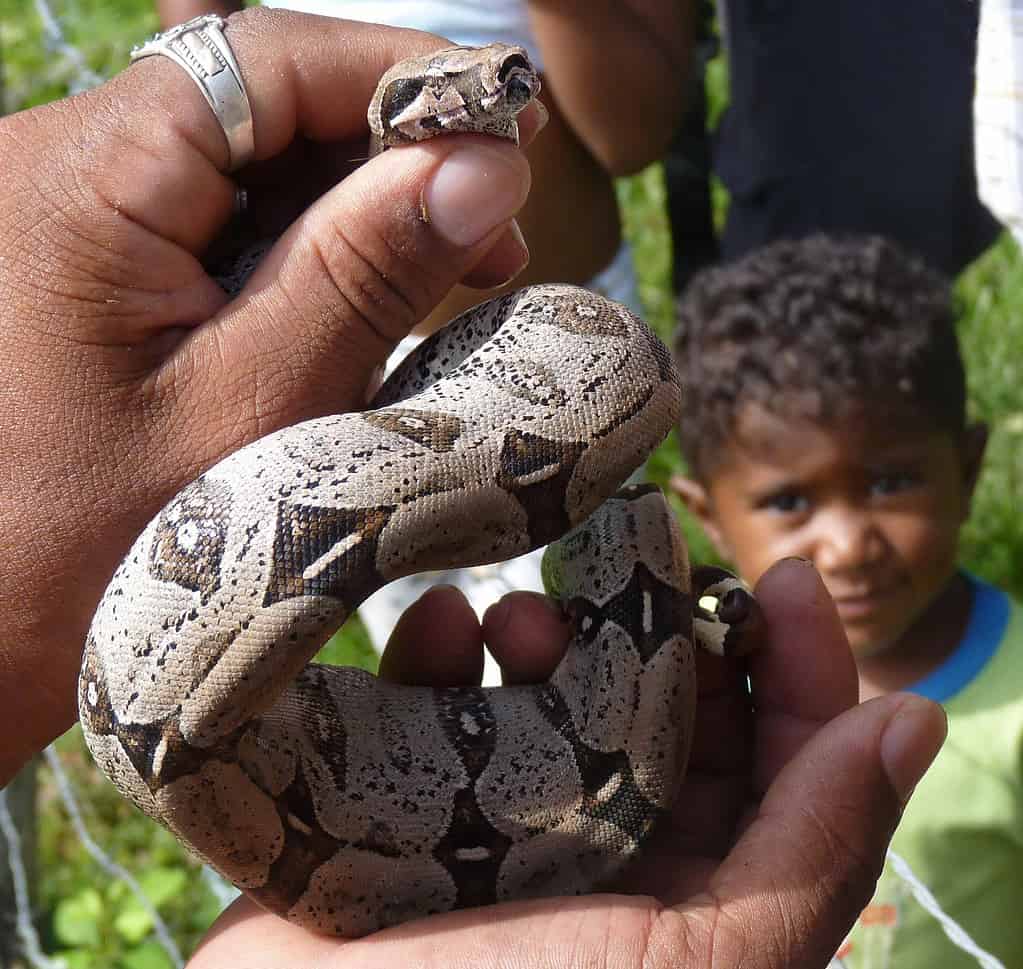
Juvenile Dominican clouded boa constrictor.
©JanRehschuh, CC BY-SA 3.0, via Wikimedia Commons – License
Out of all the boa constrictor snakes on this list, the Dominica clouded boa has one of the neatest names. As the name indicates, this boa species comes from Dominica, an island in the Caribbean often confused with the Dominican Republic.
Nebulosa boas are typically brown to gray in coloration, with several distinct patterns that become far less so as they age. Since Dominica is largely a rainforest in the middle of the sea, clouded boas are right at home.
One of their favorite meals is a bat, of which there are plenty on the island. These boas average between 7′ and 8′ in length, and they have an unfortunate disadvantage that their cousins don’t share. As a Dominican clouded boa reaches its twilight years, its vertebrae will lock together, making movement and feeding very difficult.
7. Saint Lucia Boa (Boa orophias)
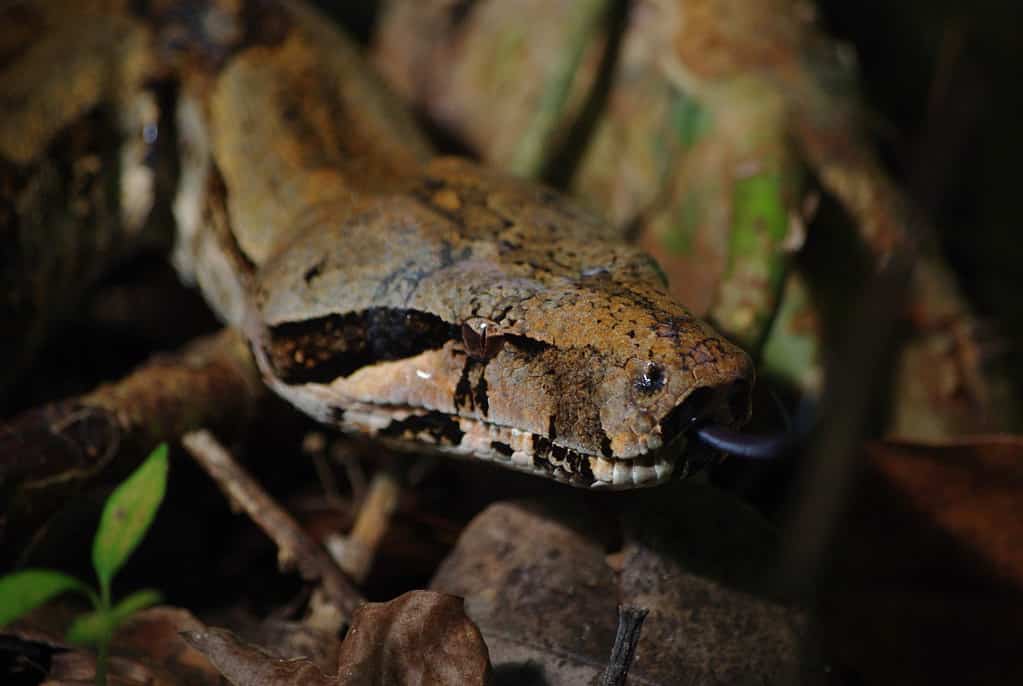
St. Lucia boa says “Hello there.”
©Edward Bell, CC BY 4.0, via Wikimedia Commons – License
The Saint Lucia boa also goes by the name of Tet Chyenn, thanks to its uniquely dog-shaped head. The head is the easiest way to identify them since their colorations are very similar to other boas on this list. However, some Saint Lucia boas get pretty dark, with patterning that’s difficult to discern.
Once upon a time, Saint Lucia boa constrictor snakes were quite popular among pet owners. For vague reasons, they no longer enjoy that status. On Saint Lucia, these boas happily feed on the island’s bat population, along with mice that unfortunately cross their path.
Though the locals on the island are not too fond of snakes, killing a Saint Lucia boa is a criminal act, bringing a fine of $5,000.00 in US dollars.
8. Short-tail boa (Boa constrictor amarali)
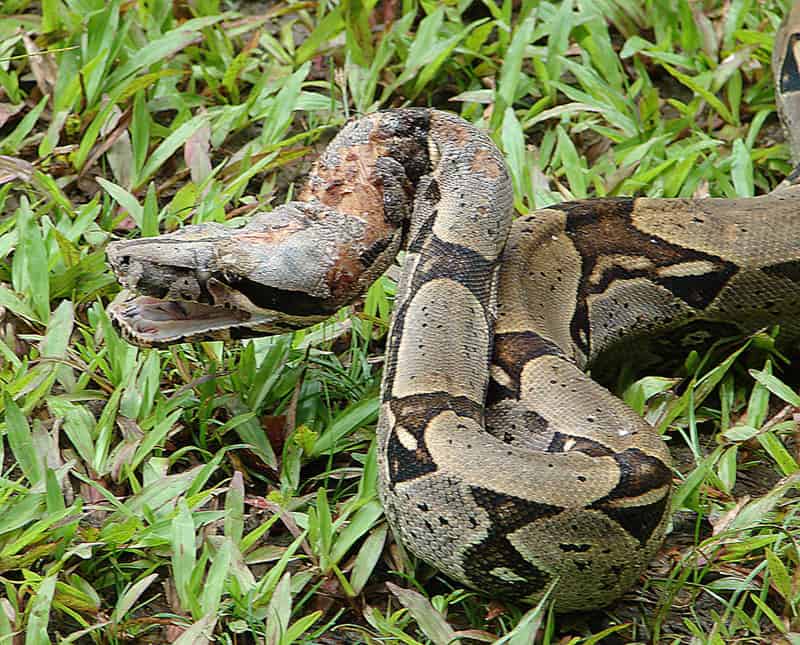
Short-tail boa in a defensive position, hissing.
©Dick Culbert from Gibsons, B.C., Canada, CC BY 2.0, via Wikimedia Commons – License
The opposite of the longicauda, amarali, or short-tail boa constrictor, was once known as a boa imperator. It seems like a lot of the boas on this list—and other lists of sub-species—were once known as boa imperators or are still confused with imperators today.
The short tail was discovered by Dr. Afrânio Do Amaral, from which its name is derived. Their habitat ranges from Brazil to Bolivia and are mostly the same colors as standard boas. However, some short-tails feature a silvery coloration that earns them the nickname, ‘silverbacks.’
Since there is so much interbreeding between the various boas in South America, some short-tails share physical characteristics with specific boas while other short-tails are more like other boas. It can get pretty confusing, especially if you lack an eye for the most subtle distinctions.
Other Boa Snakes
There are a lot of boa snakes out there, most of which fall into the sub-species category or are currently in a tug-of-war battle between full species affiliation and sub-species. Some snakes are thought of as boas that would surprise most people, such as anaconda.
Anaconda
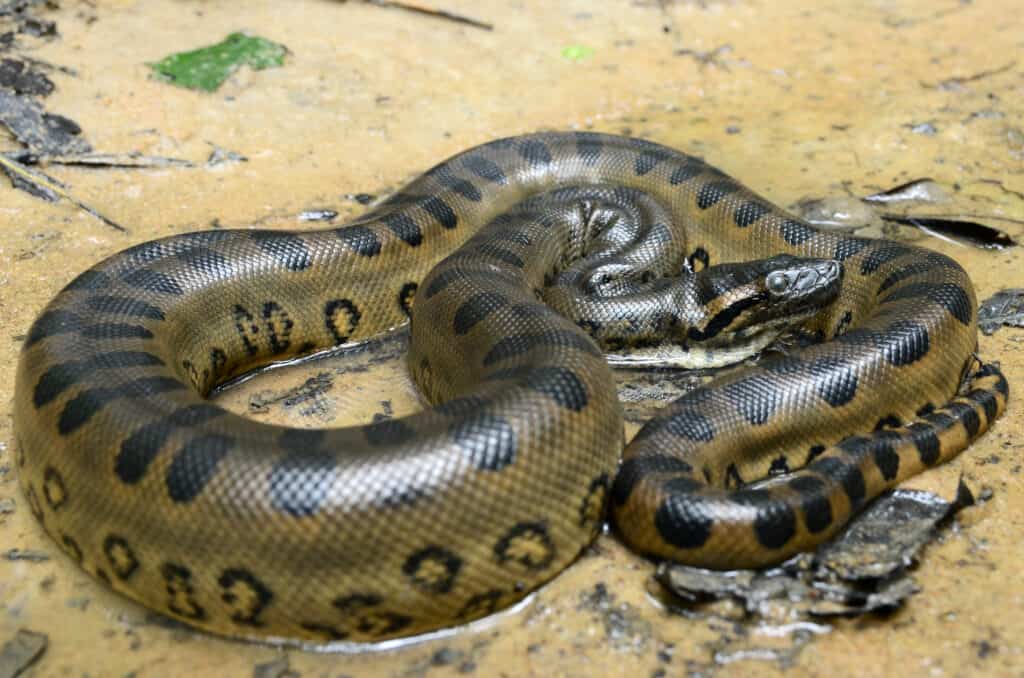
The word ‘anaconda’ is thought to come from either the Sinhalese ‘henakanday’ (meaning ‘thunder snake’), or the Tamil ‘anaikondran’ (meaning
elephant
killer).
©Patrick K. Campbell/Shutterstock.com
Otherwise known as ‘water boas,’ anacondas are the world’s largest snakes in terms of body weight, and they’re also the longest, except the reticulated python.
Garden Tree Boa
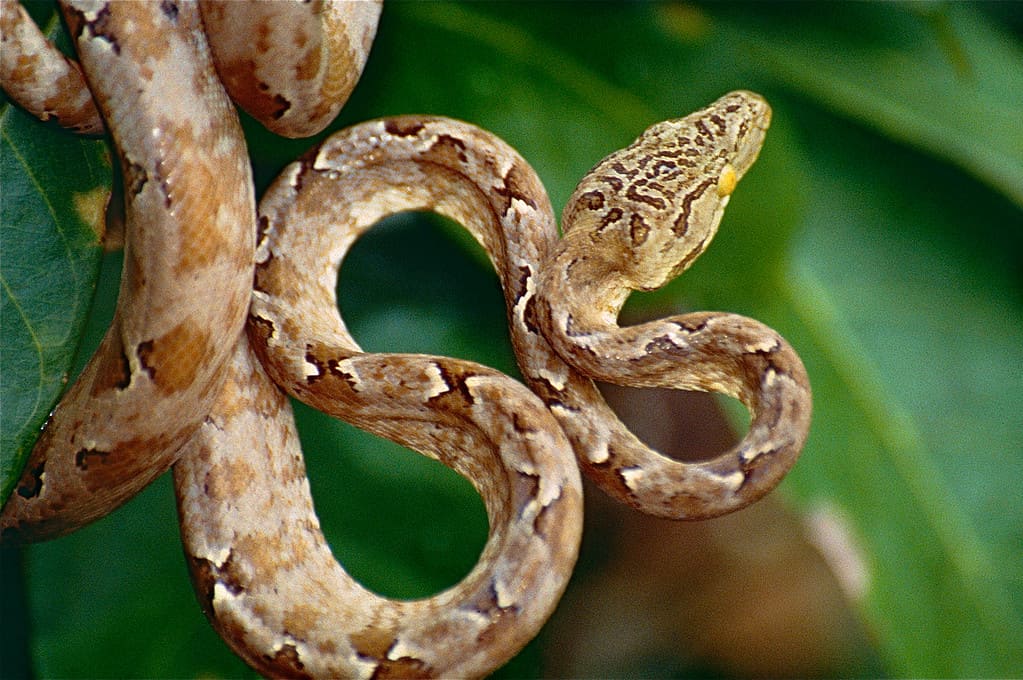
©Bernard DUPONT from FRANCE, CC BY-SA 2.0, via Wikimedia Commons – License
One of the smaller species of boas, garden tree boas are native to South America and also feature a broader color spectrum than any of the boas listed above.
Rubber Boa

A coiled Northern Rubber Boa
©yhelfman/Shutterstock.com
Rubber boa constrictor snakes are typically found in North America. They get their name from their distinctively rubber-like appearance, along with their solid colors and patterns. Rubber boas are also the smallest boa constrictors in the world.
Rosy Boa
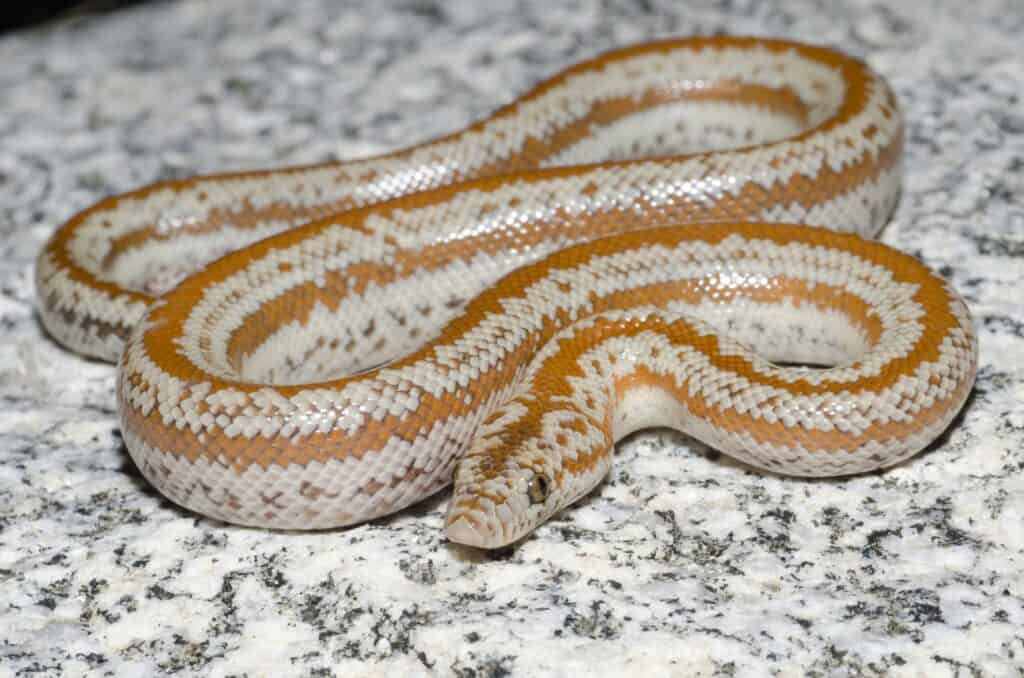
©Jason Mintzer/Shutterstock.com
Most people probably don’t see anything rosy about a snake. However, the rosy boa is about as close as it gets. These boas feature an off-pink coloration against a cream-white background. Their native area runs from Mexico up into California.
Emerald Tree Boa

The Emerald boa is also known as the green tree boa. They catch most of their prey while they hang from a branch to snatch them off the ground.
©Hannamariah/Shutterstock.com
As one might imagine, the emerald tree boa is a vivid, bright green and enjoys spending most of its time coiling around a sturdy branch. Primarily a South American snake, emerald tree boas have larger and longer teeth than almost all other snakes their size.
Sand Boa
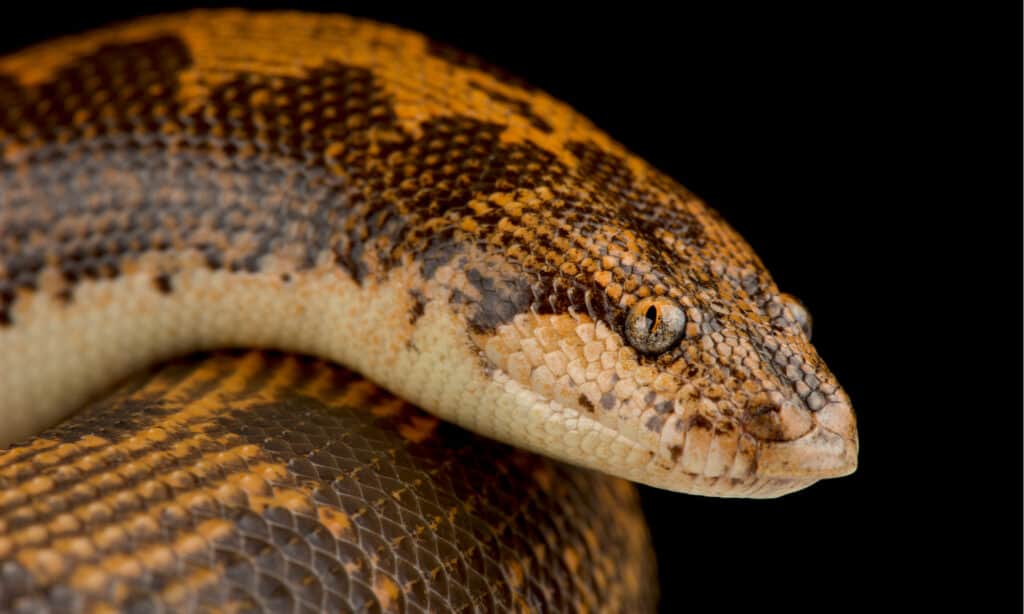
Kenyan Sand boas’ eyes are placed higher on their heads because they bury themselves in the sand and need to see.
©reptiles4all/Shutterstock.com
You have to head over to Africa if you want to run into a sand boa. As their name implies, the sand boa spends most of its time burrowed down into fine sand. They have a rust-colored appearance that runs the gamut between red and orange hues.
Rainbow Boa

is a boa species endemic to Central and South America. Common names include the rainbow boa and slender boa. The snake has a wider head than the neck.
©iStock.com/Murilo Gualda
Rainbow boas get their name from the iridescent sheen their scales display when the sunlight hits them. They’re captive-bred and widely available in the pet trade and are pretty easy-going for experienced keepers.
Dwarf Boa
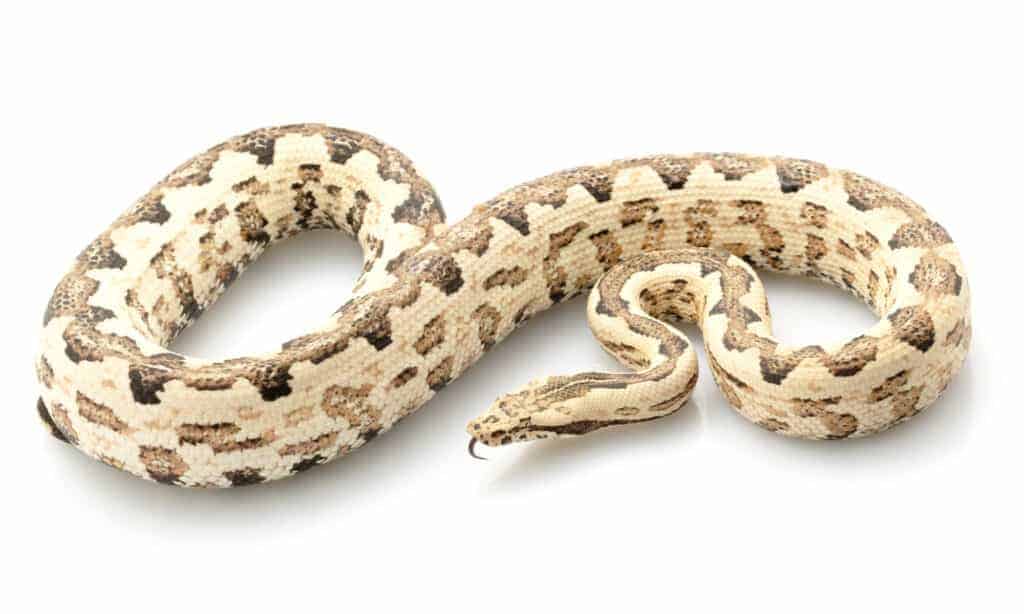
©fivespots/Shutterstock.com
Dwarf boas are primarily South and Central American snakes, though they are also in North America. They like elevated environments and moist, forested surroundings. These boas are below even a sub-species of boa, and their existence is due to purposeful breeding for dwarf characteristics.
Viper Boa
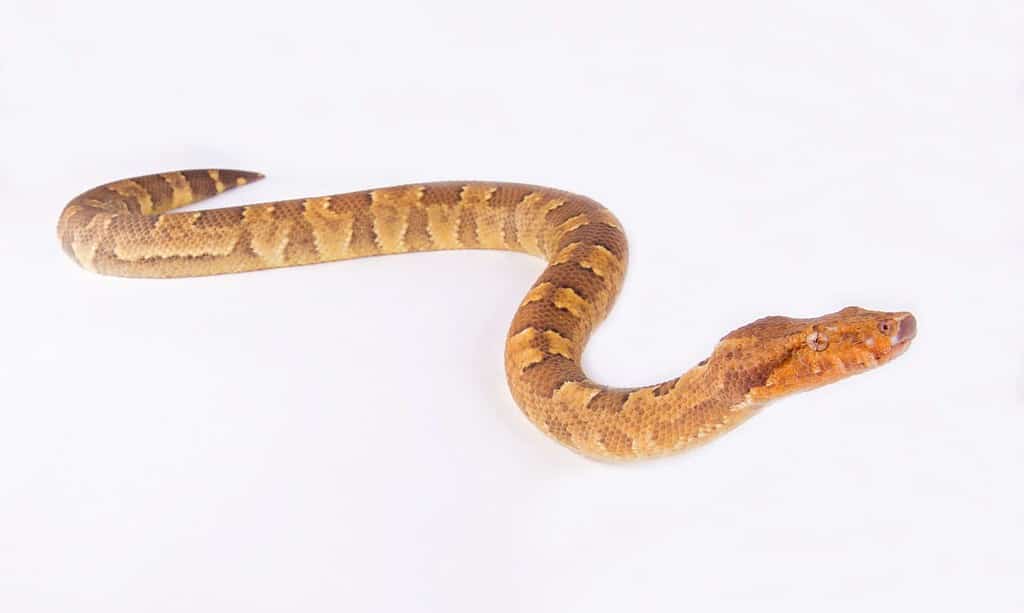
©iStock.com/reptiles4all
Only reaching between 2′ and 3′ in length, the viper boa constrictor snakes are often confused with venomous adders, though they are completely harmless to people. They are highly defensive by nature, but they just don’t possess the tools necessary to endanger people. Mice, on the other hand, well, that’s a different story.
Cuban Boa
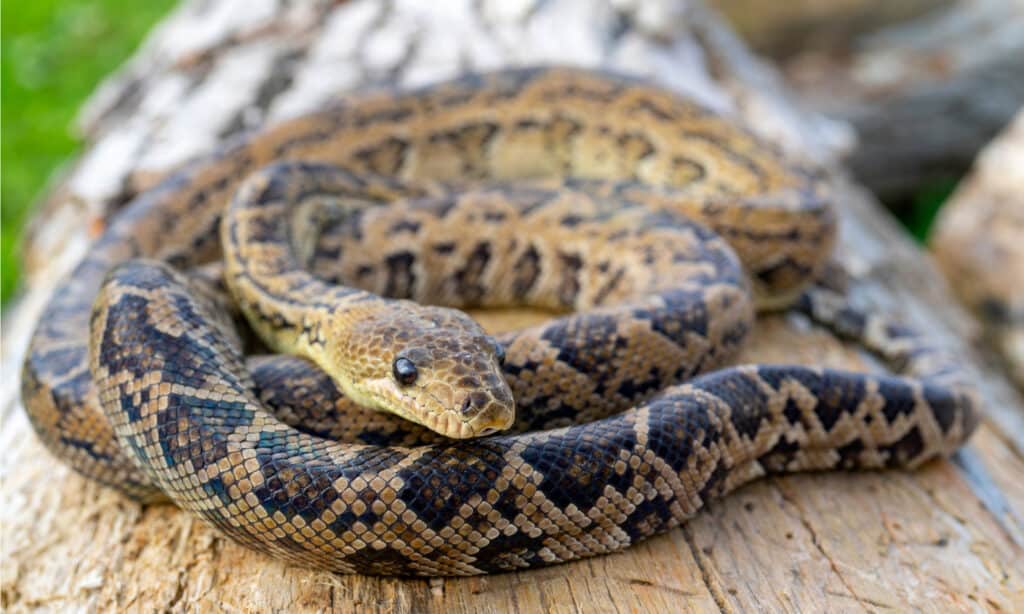
Cuban boas have sharply angular, geometric markings on their backs and sides.
©Alex Popov/Shutterstock.com
The Cuban boa is capable of reaching incredible lengths—well over a dozen feet. They have interesting, densely packed patterns that resemble pieces of some archaic block puzzle. Despite their length, Cuban boas are relatively harmless.
Dumeril’s Boa

Dumeril’s ground boa is native to Madagascar.
©Matt_Gibson/Shutterstock.com
Native to Madagascar, Dumeril’s boas found themselves at the end of the export trade, flying to all corners of the world to end up in an aquarium. They are fairly non-aggressive, though reaching in a tank fast may disillusion you from that. Tan and grayish, they have a pretty and unique pattern that’s easily distinguishable.
Jamaican Boa
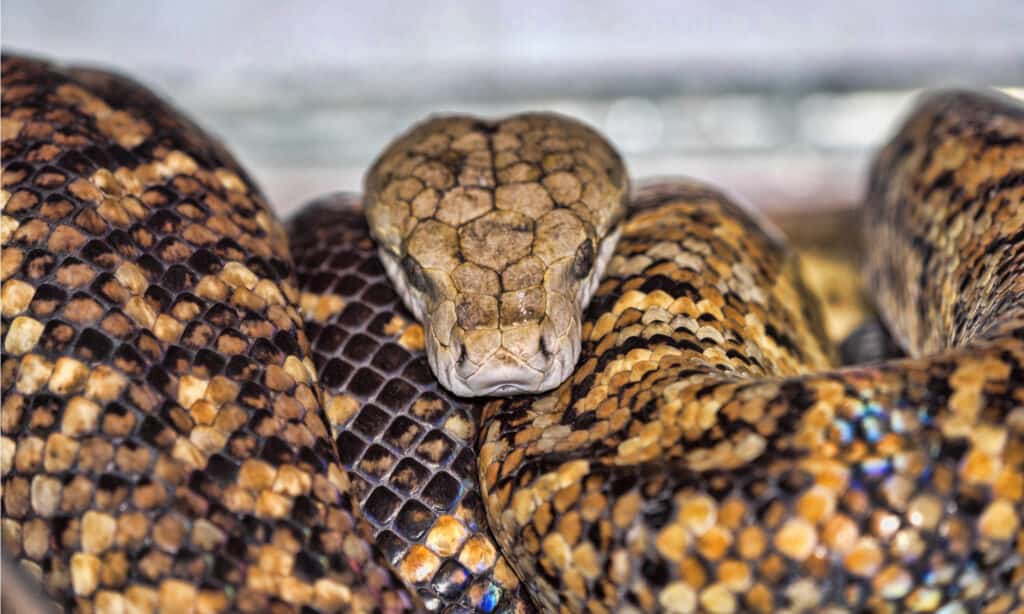
This nocturnal species is vulnerable to extinction.
©Vladislav T. Jirousek/Shutterstock.com
Often a dark green and yellow, Jamaican boas are instinctively nocturnal, which hasn’t done much to keep them off the extinction lists, mostly due to non-native animals introduced to their island. Typically between 5′ and 7′ in length, Jamaican boas are tan, gold, brown, and black, with stripe-like block patterns that sheen in the sun.
Moonglow Boa
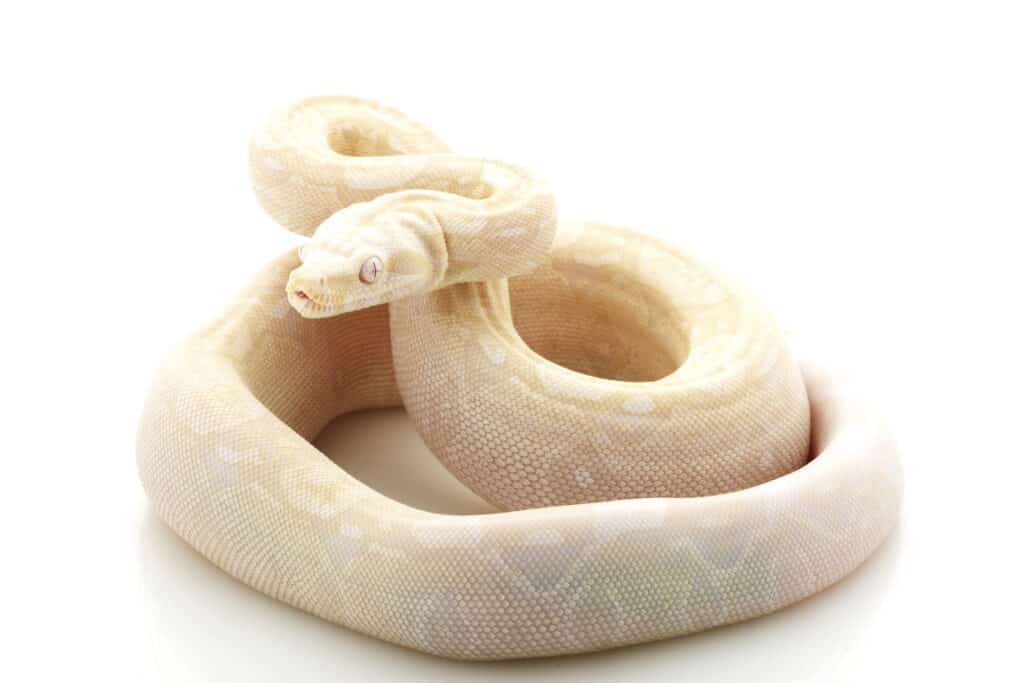
Moonglow boas are white to light yellow.
©fivespots/Shutterstock.com
If you took a bright white, fine mesh net and coated a boa constrictor with it, you might have something that resembles a moonglow boa. This beautiful snake is the direct result of selective breeding practices that eventually resulted in the pearlescent, glowing snake you see above.
Amazon Tree Boa
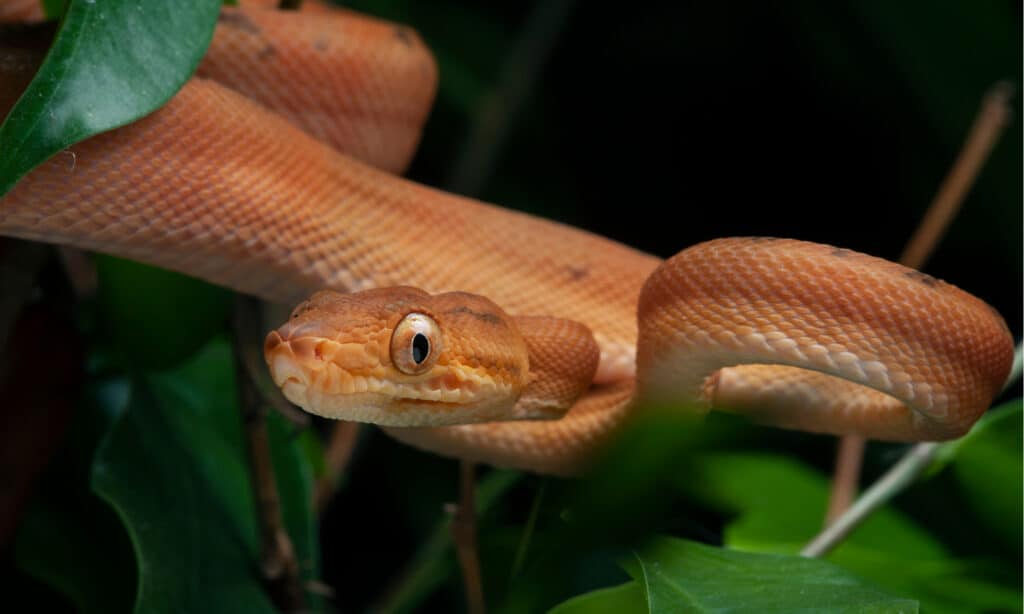
These beautiful snakes are quite defensive.
©Amazon Tree Boa/Shutterstock.com
Amazon tree boas are known for their large, orb-ish eyes and their grumpy nature. They come in a wild variety of colors, so they’re often hard to distinguish unless you know what you’re looking at. As the name suggests, they spend a lot of time in the trees, feeding on small birds, bird eggs, mice, lizards, salamanders, and frogs.
Madagascar Tree Boa
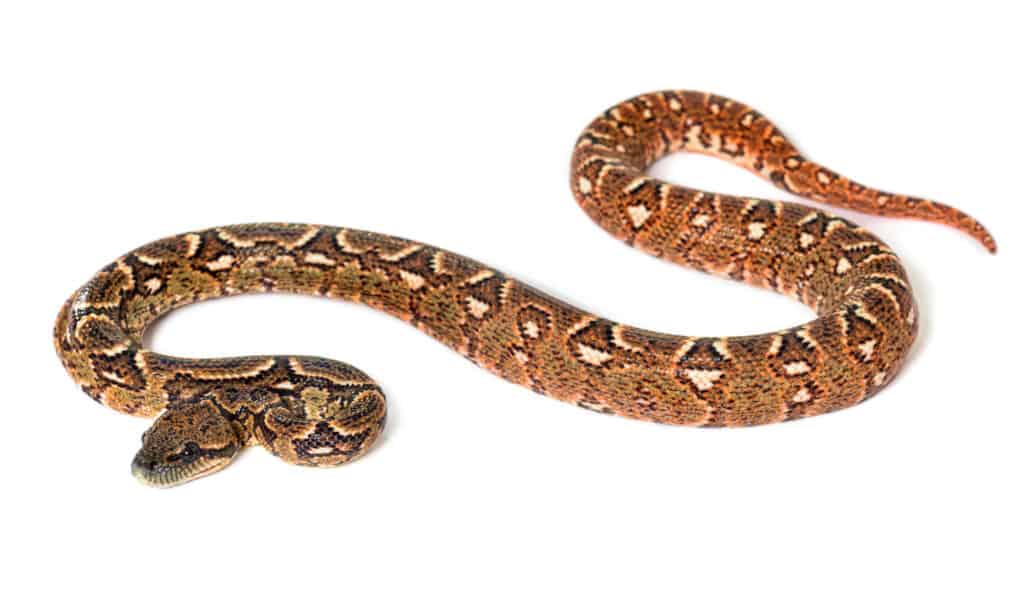
The Madagascar tree boa is born with a bright red base color that changes to greenish as they mature.
©Eric Isselee/Shutterstock.com
Madagascar tree boas grow up to 6′ in length and are relatively docile snakes. Feeding on small animals, such as mice and other rodents, these tree boas are fairly solitary. They can live for up to 20 years, and it only takes about a year or two to reach sexual maturity.
Are All Boas Actually Boas?
No, they’re not. Some of the boas on the list are not boas in the strictest sense. They’re on the list because they are called boas and known as boas. The original eight in the top half are a solid representation of some of the full and sub-species.
However, the problem lies in the constant arguments as to which species belong here and which species belong there. Boa constrictor snakes interbreed with their own and other, similar species so often that discoveries are often lumped in the wrong category. This is something that’s been going on with boa identification for a long time.
Slowly but surely, genetic testing is clearing up the fog, so to speak. As time goes by, perhaps we’ll have a better picture of what is a known, full-species boa, what is a sub-species, and what is called a boa just for kicks. Even some of the full-species boas have been removed before, so this isn’t an exact science—at least not yet.
Final Thoughts on All Boa Snakes Ever Found
The list of 8 is sometimes a list of 10. Sometimes it’s a list of 5, depending on where you look. The point is, classifying boas, especially when so many are out there, interbreeding and creating tiny variations of boa constrictor snakes, isn’t as easy as it looks. On the bright side, boas are beautiful creatures and a lot of fun to observe!
The photo featured at the top of this post is © Jan Hejda/Shutterstock.com
Discover the "Monster" Snake 5X Bigger than an Anaconda
Every day A-Z Animals sends out some of the most incredible facts in the world from our free newsletter. Want to discover the 10 most beautiful snakes in the world, a "snake island" where you're never more than 3 feet from danger, or a "monster" snake 5X larger than an anaconda? Then sign up right now and you'll start receiving our daily newsletter absolutely free.
Thank you for reading! Have some feedback for us? Contact the AZ Animals editorial team.







